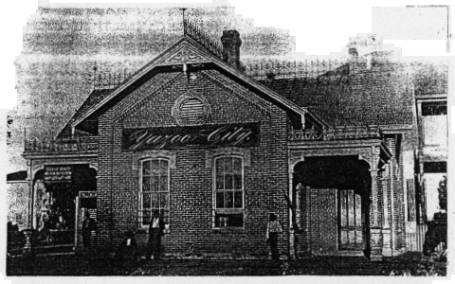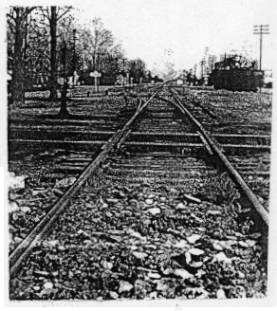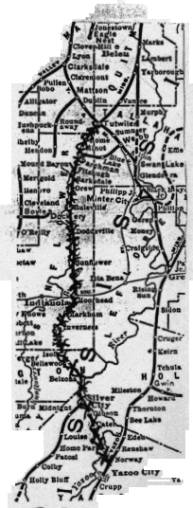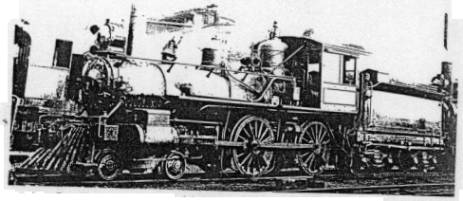
Painting © 2004 Loz
Arkle
Website
© Copyright 2000-2011 Alan White - All
Rights Reserved
Site optimised for Microsoft Internet Explorer



"This Cat's Got the Yellow Dog Blues"
- origins of the term Yellow Dog by Max Haymes
Railroads
have always been an integral part of the blues; not only in inspiring the boogie
rhythms of countless rural guitarists, barrelhouse pianists and harp blowers,
but also the lyric content of the blues singer. The earliest blues that has been
noted featured one of the most famous railroads; Mississippi’s “Yellow
Dog”. In this article I shall be not only seeking out the origin of the term
but I will also attempt to identify the railroad it refers to.
The blues in
question is the song that W. C. Handy was to “compose” later as “The
yellow Dog Blues”. In 1903 Handy has related how he heard a lean, raggedy,
black guitarist in Tutwiler’s railroad depot, singing of going to where the
‘Southern cross the Yellow Dog”. Writers have speculated the origin of this
nickname for over five decades. The picture becomes even less clear as at least
two railroads seem to be involved; the Yazoo & Mississippi Valley (Y.&M.V.)
and the Yazoo Delta (Y.D.)
The
“Southern” was the Southern Railway which “began operations in
1894,”(I). This dates the line “where the Southern cross the Dog” back to
1894 at the earliest. Cohen tells us “The Dog” was the Yellow Dog, a
vernacular name for the Yazoo Delta Railroad.”(2). “Dog” or short-dog was
railroad slang for a local or branch line. Cohen refers to Handy’s anecdote as
to how this railroad acquired the name. This involved the black trackside worker
who, when asked, looks up at the locomotive nearby and replies rather
uncertainly, that the letters “Y.D.” on the tender, stand for “Yaller Dawg,
I guess”. But no explanation was given as to the reason why.
Cohen says “The Yazoo Delta lasted for such a brief period that we can date the verse’s origin to within a couple of years. Opened in August, 1897, the Yazoo Delta first consisted of 20.5 miles of track between Moorhead and Ruelville (sic), to the north. By 1899 it had been extended in both directions – 21.5 miles to the north to Tutwiler, and 15 miles to the south to Lake Dawson. By 1903 the company was no longer in existence, having been acquired by the Yazoo and Mississippi Valley Railroad, a subsidiary of the Illinois Central Railroad. Possibly the name Yellow Dog was later applied to the Y&M.V. line.”(3). The Yazoo Delta R.R, was so short-lived that it is not mentioned in three different histories of Yazoo County or by most blues authorities when discussing the Yellow Dog. Although Paul Oliver refers to a shortened term for the line as “Yazoo Delta”(4), he is still referring to the Y&M.V. The Y.D. itself makes a brief appearance in James Cobb’s excellent “The Southernmost South” (1992). But otherwise silence reigns regarding the Yazoo Delta R.R.

Fig.
1 Y.&M.V.R.R. train station at Yazoo City, prior to 1900
On the other
hand, the first train steamed into Yazoo City railroad station on the Y.&M.V.
in 1884, some 13 years before the Y.D. came into existence. J. B. Wilson
reported at the time with obvious civic pride “this year witnessed the
completion of the Yazoo and Mississippi Valley Railroad, running from Jackson,
Miss., to Yazoo, Miss., (sic), the county seat of Yazoo...This has been built as
a feeder to the Illinois Central R.R.” (5). He adds “The Y&M.V.R.R.
connects us with the outside world at Jackson, Miss.,”(6).
But the real
clincher for the Y.&M.V. as the rightful
heir to the title “The Yellow Dog”, was the creation of the settlement of
Moorhead. When Handy heard the now-famous refrain at Tutwiler, the “ragged
Negro” was singing about “going to Moorhead, Miss., where the Southern
Railroad crossed the Yazoo and Mississippi Valley, called “Yellow Dog” by
blacks and whites.”(7). Handy gives the explanation of his 1903 guitarist:
“At Moorhead the eastbound and the westbound met and crossed the north and
southbound trains four times a day. “(8). A fairly busy railroad junction it
seems, in 1903. Over 30 years later Big Bill (Broonzy) would
declare:
“The
Southern cross the Dog at Moorhead,
an’ she keeps on through,
The Southern cross the Dog at Moorhead, an’ she keeps on through.
If my babe gone to Georgia, believe I’m goin’ to Georgia too.”(9)

Fig.
2 The famous railroad crossing at Moorhead
Unlike
Cohen, it is quite clear to me that Big Bill is referring to the Y.&M.V.
crossing the Southern, rather than the elusive Yazoo Delta R.R.
About a year
after the historic (for Yazoo City) arrival of the Y.&M.V. one Chester H.
Pond founded Moorhead, “Pond enlisted financial support in building a railroad
to service the rich lands north and south of Moorhead which resulted in some
twenty miles of track being laid. Then a chain of flat-cars pulled by a
second-hand locomotive soon earned the name of the “Yellow Dog”. (10). By
Cohen’s own admission this railroad, c.1835, could not have been the Yazoo
Delta R.R., still some twelve years in the future, so it must have been part of
the Y.&M.V. Perhaps initially, Pond leased his section of the Yellow Dog
from the Y.&M.V. or acquired running rights for his trains. Either way, this
line was so successful that the Illinois Central “finally bought the road,
extending it to Tutwiler on the north and to Belzoni on the south.”(11). This
seems to cancel out Cohen’s report, quoted earlier, on the mythical? Yazoo
Delta R.R. Besides, it was well known in Mississippi around the turn of the
century that although the Y.&M.V. retained a separate name into the 1920s,
it was in fact a part of the I.C. Hence the monopoly scare of 1892 when the I.C.
in the guise of the Yazoo & Mississippi Valley RR. bought out the
Louisville, New Orleans and Texas Railway Company which had become a serious
threat to the I.C. in the Delta. Mississippian industrialists and politicians
saw the $25,000,000 purchase as an extension of the monopoly of Northern
capitalists; in the shape of the Illinois Central. The L.N.O.&T. ran from
Memphis to New Orleans but now as part of the Y.&M.V. In 1938, N .S. Adams referred to the section of the Y.&M.V.R.R. from
Clarksdale to Yazoo City as “the route commonly known as the Yellow
Dog”,(12), but did not state why. In any case, the train would have to jump
the tracks in its efforts to branch from Moorhead to Clarksdale on its arrival
in Tutwiler! (see Fig.3.).
Even if
there had been a Yazoo Delta R.R. which crossed the Southern for only four years
(1899-1903), according to Cohen, it is unlikely that the reference in Charlie
Patton’s “Green River Blues” had the Y.D. in mind. Patton would only have
been about 12 years old when the latter railroad was allegedly swallowed up by
the Y.&M.V. In 1929 he sang the verse Handy had heard in Tutwiler:
“I’m
goin’ where Southern cross the Dog,
I’ni goin’ where the Southern cross the Dog.
I’m goin’ where the Southern cross the Dog.”
(13).
 By
this time, the Y.&M.V. had been the only “Dog” crossing the Southern for
some 26 years. Handy of course composed his “Yellow Dog Rag” in 1914 which
later became “The Yellow Dog Blues”. In this form the tune was
recorded by jazz bands and vaudeville-blues singers in the 1920s. In February, 1923, Lizzie Miles cut
what is probably the first recording of the Handy composition, by a blues
singer, as “The Yellow Dog Blues” in New York City. It was to be another two
years or more before Bessie Smith put her most famous version on wax,
accompanied by Fletcher Henderson’s Hot Six. But there does not appear to be
any recordings of Handy’s song by rural blues singers.
By
this time, the Y.&M.V. had been the only “Dog” crossing the Southern for
some 26 years. Handy of course composed his “Yellow Dog Rag” in 1914 which
later became “The Yellow Dog Blues”. In this form the tune was
recorded by jazz bands and vaudeville-blues singers in the 1920s. In February, 1923, Lizzie Miles cut
what is probably the first recording of the Handy composition, by a blues
singer, as “The Yellow Dog Blues” in New York City. It was to be another two
years or more before Bessie Smith put her most famous version on wax,
accompanied by Fletcher Henderson’s Hot Six. But there does not appear to be
any recordings of Handy’s song by rural blues singers.
However,
in 1927 a Louisiana-born singer, who played in McComb, Miss. a great deal, did
record “Yellow Dog Blues” with slide guitar, possibly played across his lap.
This was the manner in which Handy described his guitarist playing in Tutwiler,
and what he heard could well have been the original “Yellow Dog Blues”.
Fig. 3 The Yellow Dog
The
1927 recording, by Sam Collins, (a contemporary of Charlie Patton, Frank Stokes
and Peg Leg Howell), departs
from Handy’s composition and may
well
be the only
recorded evidence of the original blues:
“Be easy
mama, don’t you fade away,
Be easy mama, don’t you fade away.
I’m goin’ where that Southern cross the Yaller Dog.”
“I seed
‘im? here when you was fightin’ all ‘round the hail,
Lord, I seed ‘im here when ‘e? were fightin’ all ‘round the hail.
An’ I felt so rowdy an’ I
didn’t wanna ride no train.”
“I would
ride the Yaller Dog but wary? of Mary Jane,
I wanna ride the Yaller Dog, were wary of Mary Jane.
I dug deep in my saddle, an’ I don’t deny my name.”
“Dug deep
in my saddle, Lord, an’ I don’t deny my name.
Just as sure as the train leaves around the curve.”(14)
I am open to
any suggested alternative transcriptions, especially in the second stanza! Apart
from including the oft-quoted line which inspired W. C. Handy, Collins’ blues
recalls Georgia blues man, Barbecue Bob and his “Easy Rider Don’t You Deny
My Name” recorded the same year, and also the bawdy “Winin’ Boy Blues”
which Jelly Roll Morton was to later immortalize for the Library of Congress.
The various
reasons for calling the Y.&M.V.
line between Yazoo City and Tutwiler, the “Yellow Dog” really need
explanations in themselves! Apart from the rather obvious one about a dog
chasing the train as it passed through Rome, Miss.
(reported by a WPA writer in 1938); I mean some dogs will chase any
moving vehicle.
The story of
how the name was applied to this railroad by the Southern in “friendly
rivalry” has appeared several times but remains mystifying. The sometimes
gangster-ish tactics of the railroad ‘robber barons’ in the 19th. century
are too well known to reiterate here. They were more likely to cut the financial
throat of another railroad in “friendly rivalry”! The chain of flat-cars
hauled by an old locomotive might have some railroad jargon which converts to
“yellow dog” but this remains obscure.
It is
however, a term used by railroad (and others) workers that I believe explains
why they called the Y.&M.V. line the Yellow Dog. This involves an industrial
setting commencing in the 19th. century. The Knights Of Labor “Beginning as a
small society of garment workers in 1869,...evolved into a national organisation
numbering 700,000 members.”(15). Despite much resistance from employers and
communities “the Knights achieved some success, and in 1888 there were thirty
three locals in the state. (Mississippi). But partly as a result of intensified
employer resistance and partly the widespread use by employers of the “yellow
dog” contract as a condition of employment, the Knights lost membership and by
1900 were almost extinct as a national union.”(16). The ‘yellow dog’
contract is explained in a footnote: “The employee is required to sign a card
stating he is not a union member and would not join a union as long as he worked
for the company.”(17). The phrase in its most derogatory form meaning a coward
or in union parlance a “scab”. “...the term “yellow dog” stigmatized
the conduct of the individual willing to be bound by such an agreement.” (18).
Such a
weapon would be only too readily appropriated by other employers including the
railroad companies. In the lumber industry for instance, in 1915 “the Southern
Pine Operators’ Association maintained records of all workers applying for
jobs in the southern lumber companies, and forced the workers to sign away their
right to organize through the acceptance of a “yellow dog” contract”.(19).
Perhaps Moorhead’s founder, Chester H. Pond, used non-Union labour on his
initial section of railroad in the middle 1880s. The Y.&M.V.R.R. might also
have been similarly fixed until the line was ‘merged’ officially into the
accounts or its parent, the almost wholly-unionized Illinois Central, in 1924.
As late as 1925 about 30 miles of the railroad was leased to other smaller
railroads (see 20), which in all probability would have been non-Union.
If one of
these companies had leased some of the Y.&M.V. in 1903 which included
Moorhead and/or Tutwiler, there might have been some derogatory graffiti on the
locomotive such as an abbreviated reference to the yellow dog contract i.e. “Y.D.” This would explain the black section hand’s hesitancy when giving
his explanation for these initials. After all, he would know right away if the
letters stood for the company who was paying him! Some 25 years later, in 1928,
the great blues singer, Lucille Bogan recorded “Payroll Blues” and included
these lines:
“Pay day
on the Southern, pay day on the Yaller Dog,
Pay day on the Southern, pay day on the Yaller Dog.
An’ I want to meet that pay roll an’ try to make a water-haul.”
“Mens out
on the Southern they make dollars by the stack,
Mens out on the Southern they make dollars by the stack.
An’ I have money in my stocking when that payroll train gets back.” (21)
Although
blues lyrics cannot always be taken as autobiographical, it is clear from the
amount of detail that Bogan includes in this and other blues, that she had a
husband/lover who was a railroad employee and probably a fireman, at some stage
in her life. Although based in Birmingham, Ala., Ms. Bogan was originally from
Amory, Miss, in Monroe County and not too far from the Y.&M.V. system. The
payroll train was a phenomenon of the railroads in the earlier part of this
century and travelled many miles, often almost literally stuffed with money,
being the workers’ wages for the last month or more. The implication in the
singer’s lines is that the Southern were far better payers than the “Yazoo
Delta”/Y.&M.V. railroad. If the latter were indeed a non-Union company
they would have usually been paying well below Union rates and hence become the
Yellow Dog.
If indeed the Yazoo Delta R.R. ever existed. Despite a report in 1913 which said that Crenshaw, Miss, in Panola County, was a “new town recently built in the extreme northwestern of the county on the Yazoo Delta railroad,”(22). The Yazoo Delta was a designated geographical area from way back in the 19th. century; when the above report: referred to the only railroad (apart from the I.C.) there was in that part of the Delta, they meant THE Yazoo Delta railroad.

Fig. 4 The Yellow Dog
This became another name for the railroad used by local Mississippians
and was passed on down to the 1950s when blues researcher/author Sam Charters
picked it up and used the phrase “Yazoo Delta railroad” for the caption of
his photo of Moorhead (see Fig.2.). But the company was the Yazoo &
Mississippi Valley Railroad, a subsidiary of the Illinois Central, known widely
in the area by its more popular nickname. Said McIlwaine “So much a part of
living in the Upper Delta was the Yellow Dog, which connected with the Southern
Railway, that black singers made up a song about it...”(23).
An obscure bluesman, Lost John Hunter, even recorded a “Y.M.&V.
Blues” (sic) in the early 1950s in a Chicago style setting with some fine
piano, electric guitar and drums; although he does not include the name
“Yellow Dog”.
The name was
even applied to a locomotive on the Y.&M.V. from the late 1880, which Yazoo
City authorities erroneously referred to as a “train”. (see Fig.4.). But if
it originated with an early form of this railroad, the origin of the term, I
believe, lies in the murky industrial past of the bully-boy tactics of some of
Mississippi’s 19th.(and 20th.) century employers. Nor is my proposed theory
entirely new. In 1954 Frank Smith alluded to the yellow dog contract as a
possible origin for the Y.&M.V. nickname. “One story has to do with the
contract under which the railroad workers were hired.”(24). If this earlier
Delta railroad was a non-Union company, then this would point to the ‘Yellow
dog” contract as being the source of its nickname “The Yellow Dog”
celebrated by blues singers and blacks and whites generally, throughout the
South: before the Second World War. The line in question ran from Yazoo City to
Tutwiler crossing the Southern at Moorhead on the way. The Yazoo &
Mississippi Valley R.R. thus becoming immortalized in the famous blues line
first noted in 1903: “I’m goin’ where the Southern cross the Yellow
Dog.”
Notes
1. Webb W,
Preface.
2. Cohen N.p.442..
3. Ibid.
4. Oliver P.p.67.
5. Wilson J.B.p.p.48-49.
6. Ibid.p.28.
7. Mcllwaine S.p.331.
8. Handy W.C.p.74.
9. Broonzy B.
10. Briegar J.p.L60.
11. Ibid,
12. Adams N.S.p.34.
13. Patton C.
14. Collins S.
15. Mosley D.p.250.
16 Ibid .p .251.
17. Ibid.
18. Adams J.T.p.504.
19. Todes C.p.97.
20. Rowland D.p.558.
21. Bogan L.
22. Riley F.L.p.13.
23. Mcllwaine. Ibid.p.254.
24. Smith F.E.p.p.209-210.
Illustrations
Fig.1 -
DeCell & Prichard.p.353.
Fig.2 – Charters S.p.3.
Fig.3 - Brandfon R.L.p.85.
Fig.4 - DeCell etc. Ibid.p.354.
References
1. Adams James Truslow. (Ed.).
“Dictionary
Of American History Vol.V”. Charles Scribners’ Sons. New York. 1940.
2.
Adams U.S.
“History
Of Yazoo City-Pt.2”. Manuscript in i1ississippi Collection.
University of Mississippi. 1938.
3.
Bogan L.
“Pay Roll
Blues”. Lucille Bogan vo.; Tampa Red gtr.; poss. Georgia Topno. 8 Oct. 1928.
Chicago.
4.
Brandfon Robert L.
“Cotton
Kingdom of the New South”. Harvard University Press. Cambridge, Mass. 1967.
5.
Briegar James.
“Hometown
Mississippi”. Historical & Genealogical Association of Mississippi. 1980.
6.
Broonzy B.
“The
Southern Blues”. “Big Bill” vo.gtr.; prob. A3lack Bob pno.; unk. train,
whistle effect. 26 Feb. 1935. Chicago.
7.
Charters Samuel B.
Notes to
“Rural Blues” (2xL.P.). RB.F. RL2O2. 1964,
8.
Cohen Norm.
“Long
Steel Rail”. University of Illinois Press. Urbana. 1981,
9.
Collins S.
“Yellow
Dog Blues”. Sam Collins vo.gtr. 23 April,1927. Richmond, md. or Chicago.
10.
DeCell Harriet & JoAnne Prichard.
“Yazoo-Its
Legends and Legacies”. Yazoo Delta Press. 1976. Rep. 1977.
11.
Handy W.C.
“Father Of
The Blues”. Sidgwick & Jackson. London. 1957.
12.
Mcllwaine Shields.
“Memphis
Down In Dixie”. The Colonial Press Inc. 1948.
13.
Mosley Donald.
“The Labor Union Movement”. From “A History Of Mississippi Vol.2”. Ed. R.A.McLemore. University & College Press of Mississippi. Jackson. 1973.
14.
Oliver Paul.
“Blues Fell This Morning”. 2nd. Ed. Cambridge University Press. 1990.
I5. Patton
C.
“Green
River Blues,”. Charlie Patton vo. gtr. c. Oct. 1929. Grafton, Wis.
16.
Riley Franklin L. (Ed.).
“Mississippi Historical Society. Vol. XIII”. University of Mississippi. 1913.
17.
Rowland Dunbar.
“History Of Mississippi-The Heart Of The South Vol.11”.
The S. J.
Clarke Publishing Company. Chicago-Jackson. 1925.
18.
Smith Frank E.
“The Yazoo River”. Rinehart & Company Inc. New York. 1954.
19.
Todes Charlotte.
“Labor And Lumber”. International Publishers. New York. 1931.
20.
Webb William.
“The
Southern Railway System-An Illustrated History”. The Boston Mill8 Press.
1986.
21.
Wilson J.B.
“Handbook Of Yazoo County, Miss.” Manuscript in Mississippi Collection. University of Mississippi. 1884.
22. Pre-war
discographical details (unless otherwise stated) from: “Blues & Gospel
Records 1902-1943’. R.M.W.Dixon & J.Godrich. 3rd. Ed. Storyville. 1982.
23.
Correction & addition by Guido van Rijn & Ernest S. Virso Notes to “Lucile Bogan (1923—1935)”.
L.P. blues Document. BD-2046 1989.
24. All transcriptions by Max Haymes. 1993.
Text Copyright © 2002 Max Haymes.
All rights reserved.
Website © Copyright 2000-2008 Alan
White. All Rights Reserved.




